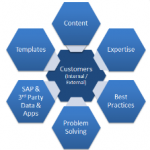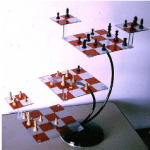Originally published on the SAP Community
Many organizations are assessing the best ways to address digital transformation holistically.
SAP and Capgemini are teaming with customers around the globe as trusted partners, to go beyond technical migration, and address intelligent business processes and new business models as part of the RISE with SAP initiative.
Capgemini’s Renewable Enterprise with SAP S/4HANA approach which is designed to put the user experience at the center. It uses modern approaches such as Artificial Intelligence (AI) and embedded analytics, DevOps, Cloud architecture, APIs and Microservices to help organizations reimagine themselves, unlock business value, and outpace competition.
Recently I had the pleasure to meet David Lowson, Capgemini’s head of SAP Center of Excellence (COE) Europe, to learn more about his journey and views related to RISE with SAP and the digital core.
Philippe Schmitt (PS): What inspired you to get into the field of consulting and high tech?
David Lowson (DL): When I worked in high-tech, I found I was a very poor engineer so when I had an opportunity to work on an enterprise resource planning (ERP) project, I took it. This experience proved I was quite good at this kind of work and is why I made the move to consultancy.
PS: In your blog Consumer Intelligence Products and Retail Therapy, you shared, “As countries around the world reopen, we observe four priority themes emerging with consumer products: sustainability, digitalization, efficiency, diversification.” How does the RISE with SAP initiative enable these themes based on Capgemini’s expertise?
DL: RISE with SAP reinforces many of the messages we have been giving to the market about the renewable enterprise, a standard core, savvy use of a cloud infrastructure and application program interface (API) led architectures. These features have been provoking more activity in the market and shifting SAP to be a platform for digital transformation.
PS: You presented at the SAP Global Partner Summit and shared that you, “believe SAP needed to launch the RISE initiative to remain relative for digital transformation for the next 25 years.” What makes this initiative so impactful to the success of customers?
DL: SAP and Capgemini are in position to address business process redesign, technical migration, and building the intelligent enterprise in one package to simplifies customers’ journey. By focusing on innovation and differentiation taking place in the SAP Business Technology Platform surrounding it, the RISE initiative is a clear statement of the importance of providing accelerated business outcomes with integration, data to value, and extensibility. It opens the door to exciting new consumption models.
PS: You’ve recently commented that the market has responded positively to RISE with SAP. Can you share one or two examples of this positive reaction from Capgemini customers?
DL: As you can appreciate, I can only speak of overall projects vs. individual projects. We have started RISE based projects all over the world. With the use of the RISE model, I have seen customers become more confident that we can deliver and provide a standard core, as well as an architecture that does not build technical debt.
PS: When Capgemini refers to the Renewable Enterprise with SAP S/4HANA, it refers to the “S Curve of Innovation” and Intelligent Technologies such as Artificial Intelligence, Machine Learning, Internet of Things, Block Chain, and the Customer Experience power by data and driven by people. What are one or two examples of how customers are adopting these intelligent technologies to support their customers and keep a competitive advantage?
DL: There are so many user cases, and we keep a library of them available for our clients and partners to access. They are also published every week by our innovation leader, Alex Bulat, Chief Technology & Innovation Officer of Global SAP Business, but the two I would pick out are:
- Servitisation – Where clients move from selling products to selling services. Think of a connected car or washing as a service; this is a perfect solution for the new away of thinking. Multiple products orchestrated to deliver new digital businesses that flex as the market develops.
- Sustainability – So many of our large engagements are driven by this concept, especially the desire to operate in new, low carbon markets. This requires greater connectivity, artificial intelligence (AI), use of data and a fast-agile core.
PS: When students and recent graduates contact you for informational insights what guidance do you give for them to pursue a career in consulting and high tech?
DL: I see SAP consulting as a three-legged stool:
- Be nice and have good people skills
- Know about the industry you’re working in
- Learn about SAP products and solutions
A company like Capgemini can provide the third bullet, but the other two can be done on your own. Also, read business papers and the SAP website at least once a week. Do a bit more to engage with and understand the direction of the company and products that stand out.
—
Thank you for sharing comments on the Renewable Enterprise, Digital Transformation, or advanced Intelligent Technologies.
Please post any feedback below.
Useful Links
• SAP S/4HANA Cloud
• RISE with SAP
• SAP Analytics Cloud
• SAP Machine Learning and Artificial Intelligence



















